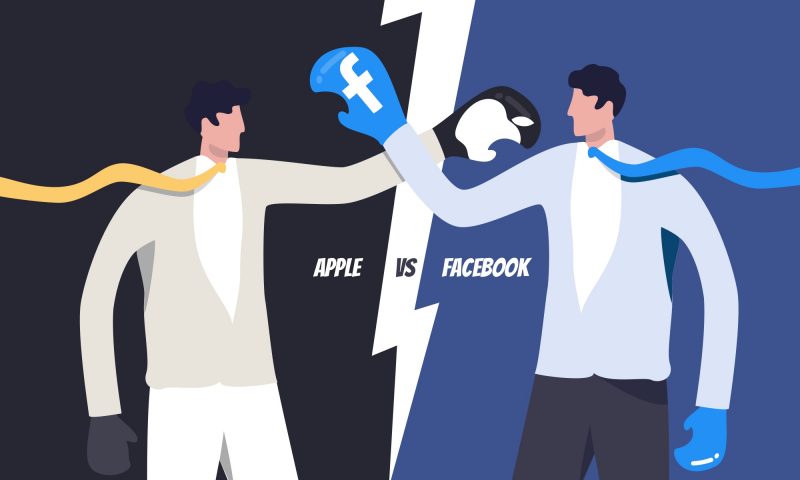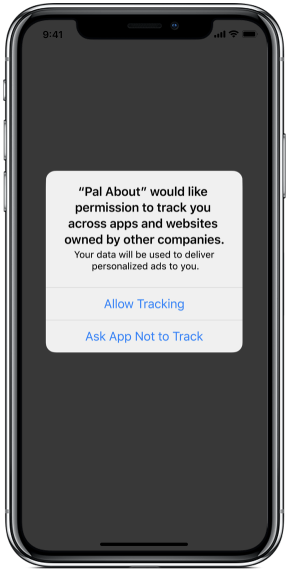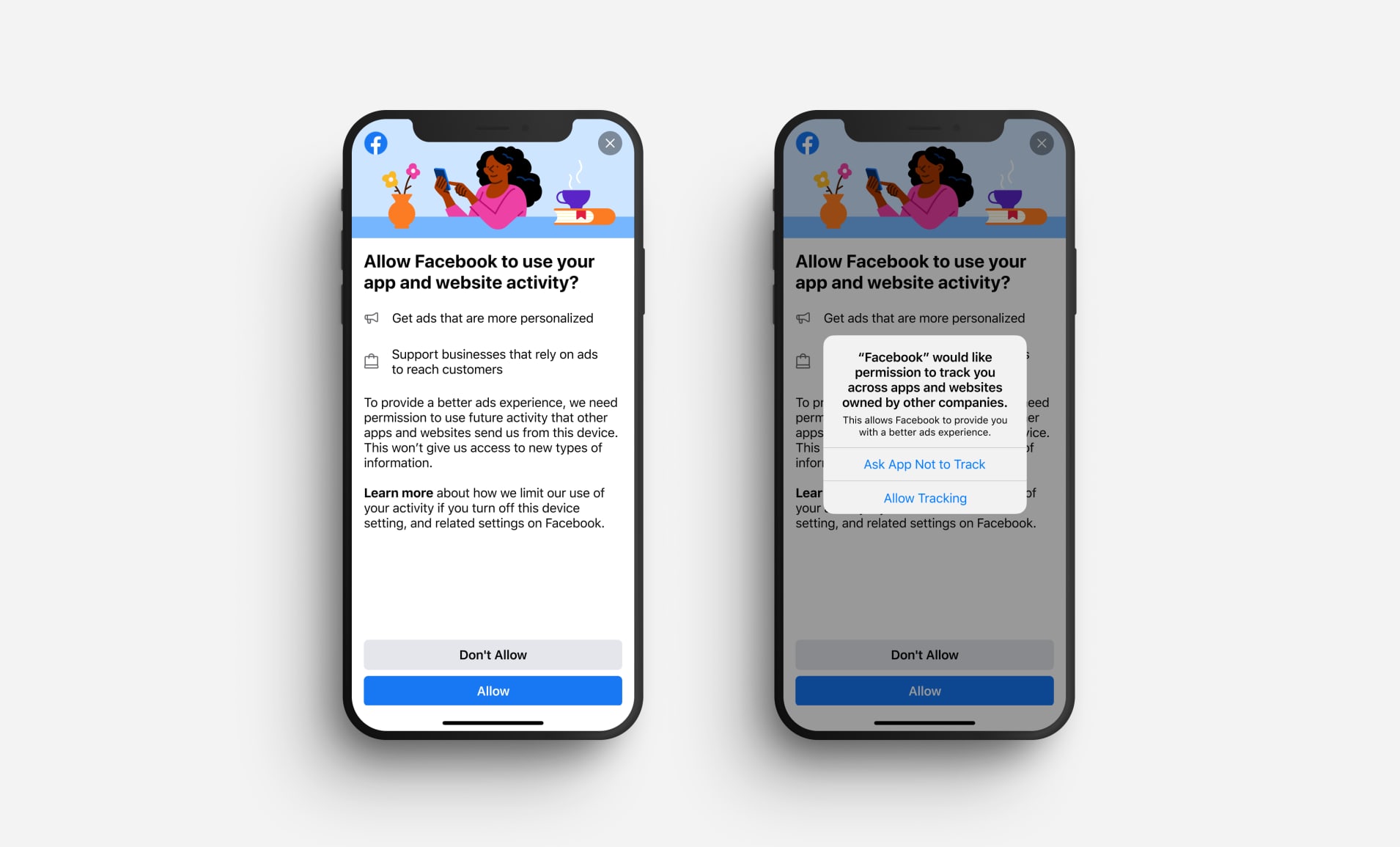“I believe people are smart and some people want to share more data than other people do. Ask them. Ask them every time. Make them tell you to stop asking them if they get tired of your asking them. Let them know precisely what you’re going to do with their data.”
Steve Jobs, All Things Digital Conference, 2010
In early spring, Apple will start asking users for permission to track and share their IDFA. The world-famous company wanted to do this even earlier, with the release of iOS 14 in the fall. However, Facebook intervened in these plans, forcing Apple to postpone the introduction of new restrictions.
Contents
Why is Apple doing this?
Recently, Mark Zuckerberg called Apple one of the biggest competitors of Facebook and added that the privacy changes would hurt the growth of “millions of businesses around the world.”
A few days later, Apple CEO Tim Cook mentioned Facebook in his speech at a data privacy conference in Brussels, saying, “If a business is built on misleading users, on data exploitation, on choices that are no choices at all, it does not deserve our praise. It deserves reform.”
Apple wants to return users’ rights to personal data. Unfortunately, these rights have been severely violated by tech giants.
It’s pretty good if, thanks to this data, you are shown ads for products that are really relevant and interesting to you. However, if your data is used to influence the opinion of voters and, in fact, change the results of the US presidential election, then this is actually not so good. Just look here at what data is collected about users in just one day.
There you can also find out what Apple is doing to prevent the use of users’ personal data.
It is quite logical here to remind Facebook’s position on Apple’s new iOS 14 privacy policy:
- Developers will have to raise prices or even become paid because advertising will now cost more. As a result, Apple will start making more money.
- Facebook predicts a 60% drop in ad sales.
- Apple’s own personalized ad platform isn’t subject to the new iOS 14 policy.
How will it work?
During the start of an application that IDFA wants to use, a dialog box will appear. A user will be asked for tracking permission:
Many believe that only few users will give this permission.
Why is it important?
Facebook, Google, and other companies use this IDFA to serve targeted ads to app users. Without IDFA, ads will become less effective as they will not be shown to the most relevant users. As a result, banners will give less conversion to targeted actions.
For example, a fitness app banner now gives one app install for $2. The cost of purchasing a user with an in-app subscription is $40 (let’s assume that the conversion from install to purchase of a subscription is 5%). With these results, the business seems profitable, since a subscription costs $50, and attracting a user who buys a subscription is $40.
Once Apple implements this request, installation costs are said to be raised by 60%. Then the installation cost will be $3.2, and the subscription cost is $64. So we get minus 14%.
The business banner has stopped working and the app has stopped earning. You need to raise your subscription prices and hope that conversions will not drop. In this case, Apple benefits, because users will pay more for applications, and Apple will earn commissions from these applications.
Facebook even told its investors that privacy changes in iOS 14, which could affect Facebook’s ability to target ads, could start to affect its business late in the first quarter. But that was said at the beginning of the year, and Apple pushed the launch of changes to early spring.
How to reduce the negative effect?
Facebook has already started doing internal testing. The company wants to understand what percentage of users will give their consent to the collection of user data.
Apple allows showing its screen in front of tracking requests, similar to how permission is requested to send push notifications or permission to access other rights (collection of geo-locations, access to user photos, etc.)
Here’s how this Facebook screen looks like:
There are two main motivators:
- Get ads that are more personalized
- Support businesses that rely on ads to reach customers
They say Facebook is now making A/B tests with different text variations for these motivators in order to increase the number of users who will include tracking.
How to track analytics for making product decisions?
Almost all serious application developers collect different analytics to make product decisions.
- What percentage of users reach the end of registration?
- At what step does a specific percentage of users fall off?
- How many percent of users subscribe to push notifications?
- What percentage of users agree to a weekly trial?
Besides, almost everyone conducts A / B testing of various hypotheses in order to increase the conversion to purchase and thus increase the profit of the application.
For example, you can show one VIP-screen to one user group, the second VIP-screen to the second group, and then see which screen gives more subscriptions. You can’t do without collecting analytics.
Fortunately, Apple does not explicitly write anywhere that it will prohibit developers from using the SDK to track user actions. But! The most popular analytics SDKs are free as they are owned by companies that sell ads or exchange data with these companies: Google Analytics, Google Firebase, and Flurry.
- Since December, when submitting an app to the App Store Connect, it is required to specify whether the app uses “third-party tracking”. Developers are encouraged to do this if they include an SDK from a company that advertises or shares data with advertisers in different apps.
- In the coming weeks, iOS 14.5 will require apps that participate in “third-party tracking” to request explicit permission, which most users will refuse.
- Moderators will soon start rejecting apps that do not meet the inclusion criteria. They will most likely do this by comparing the app’s privacy metadata against the new APIs, and also by scanning apps for specific SDKs.
- It looks like iOS apps that are currently using the Google Analytics, Flurry, and Firebase SDKs will need to ditch them as soon as possible and instead use an analytics tool not owned by the company that displays the ads. For example, such popular options as Mixpanel, Amplitude, or any custom tool.
Despite the fact that these are only guesses, there is such a risk. It is better to play it safe and implement one of the independent analytics systems (Amplitude or some other).
Feel free to explore our App Analytics tools review here – List of the Most Reliable App Analytics Tools
At Cuspy Software we use Amplitude for our apps because this solution is free for up to 10 million events. This is enough for us now.
The article will be supplemented. Keep for updates.
Here are some more useful sources for iOS app developers







